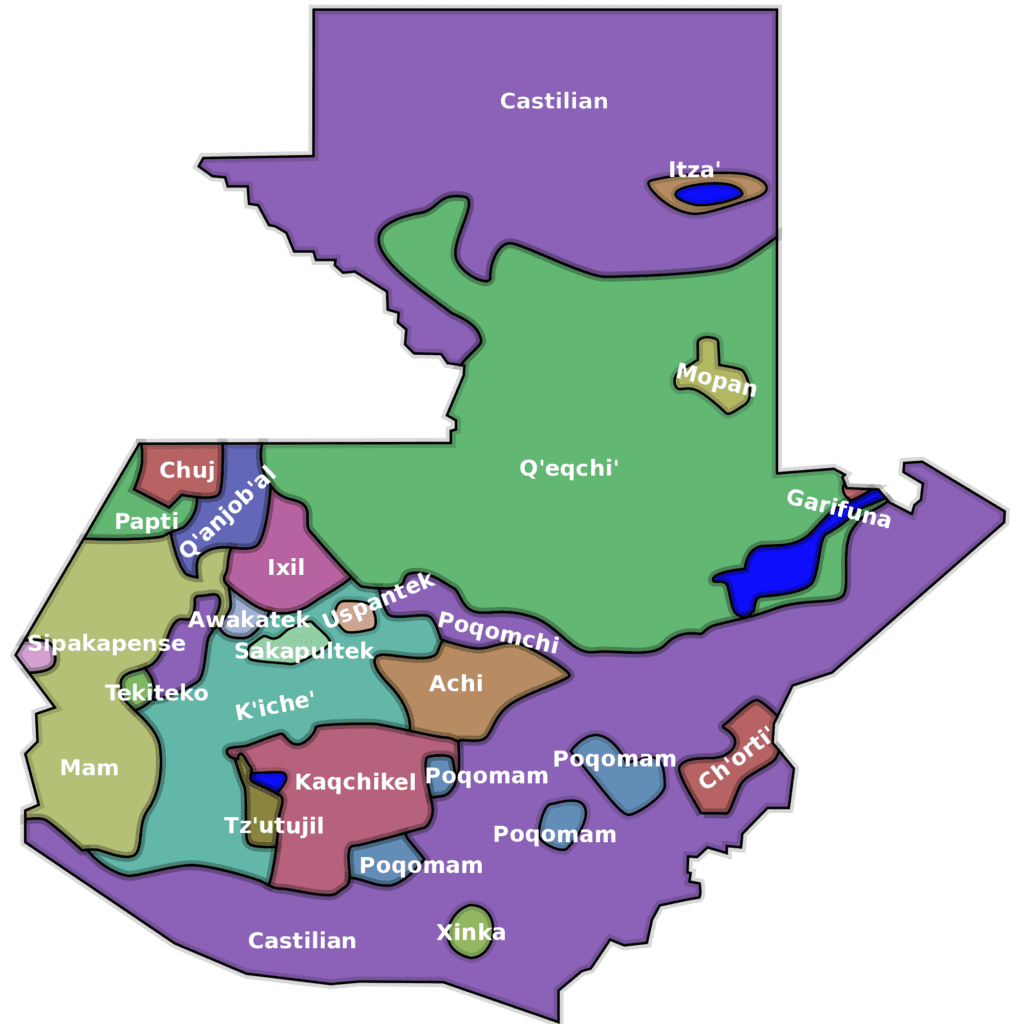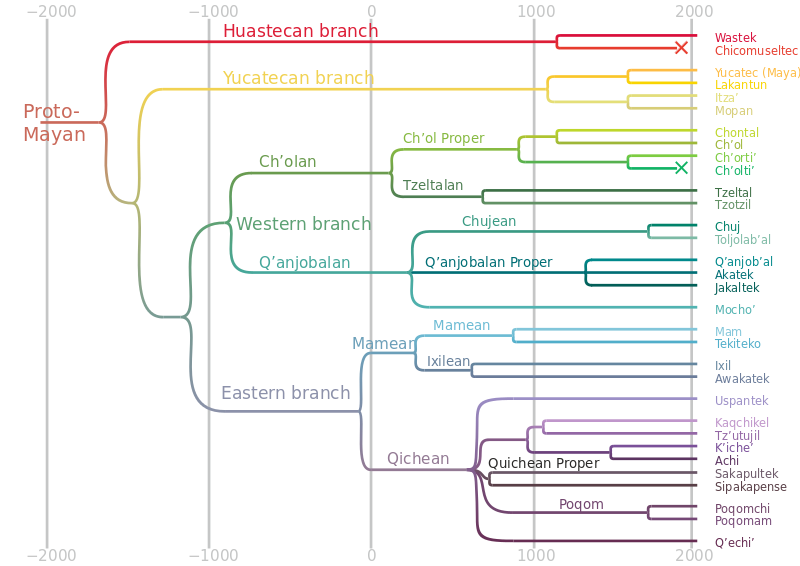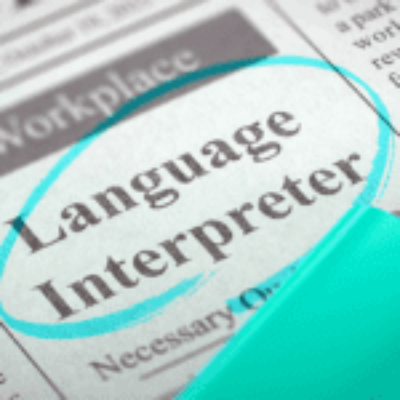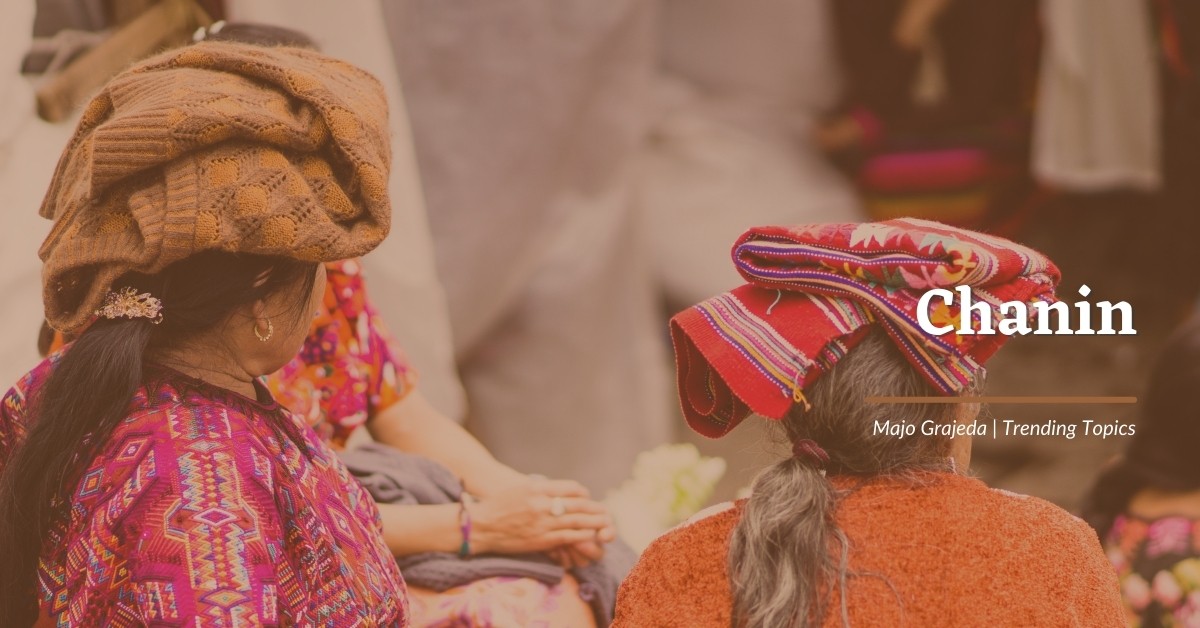
Chanin
Okay. Before we start today, have a look at this awesome video! After I watched the video, I tried to snap my fingers to chanin-chanin! It didn’t quite work and it made me remember how many years ago, my best friend spent a crazy amount of time trying to get me to do it “right.” Despite her efforts and 25 years of being Guatemalan, I still can’t make the snapping sound. Now the important question: were you able to do it? It’s okay if you can’t! That makes two of us! Either way, this expression and hand gesture has an important influence on Guatemalan culture.
Chanin, chanin-chanin, or the hand movement that accompanies those words, is ingrained in Guatemalan culture in an inexplicable way. Whether or not they actually say the words, everyone does this hand movement. Some people do it everywhere, others do it only in the familiarity of their homes. Some make it snap, while others just shake their hands like pom poms (and I raise my hand to this!!!). The video got me thinking that I do it a lot (and I mean a LOT) more often than I initially thought I do. It’s just one of those things that you learn at a very young age because everyone around you does it!
What is ‘chanin chanin’?
Let’s divide this in two and explore its meaning:
- Words: Saying ‘chanin’ or ‘chanin-chanin’
- Gesture: The famous finger snapping hand movement
The origin of the word chanin
Guatemala’s official language is Spanish. However, different cultural groups across the country speak another 24 officially recognized languages! Yes, that’s a lot of languages for one country! 22 out of those 24 languages are Mayan languages spoken by indigenous people.
Now, going back to chanin and Guatemalan Spanish. Because of the cultural exchange that exists between the various groups in Guatemala, Mayan languages have influenced – and still are influencing – Spanish greatly! Many words we use in Guatemalan Spanish, like chanin, originate from a Mayan language. Chanin, in particular, means apúrate, or hurry up.
To practice some Spanish reading, visit Guatemala’s official page on our linguistic heritage: Guatemala, un País con Diversidad Étnica, Cultural y Lingüística. There are also some maps for you to see where these different cultures and languages exist! You can also check out these Top 5 Spring Break Destinations in Guatemala and compare the places listed here to where each Mayan language is spoken.
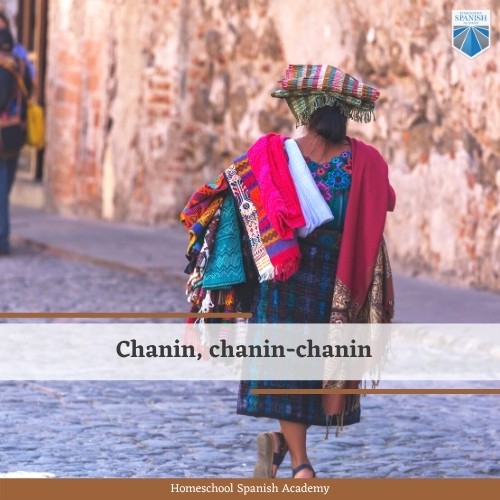
Origin of the chanin gesture
As for the hand movement, I’ve been asking some abuelitas, and no one really knows where it comes from. I can only assume that someone, one day, really needed to get something done. So, they started shaking their hands to communicate a sense of urgency to another person who spoke a different one of the 24 languages. Since they couldn’t understand each other with words, hand gestures had to do the job!
Imagine if you’re in the middle of something and someone starts frantically shaking their hands to signal that you should hurry up – believe me – you’ll hurry up!
The Languages of Guatemala
Languages are directly related to ethnic groups and culture. There are four different ethnic groups in Guatemala and one uses different languages:
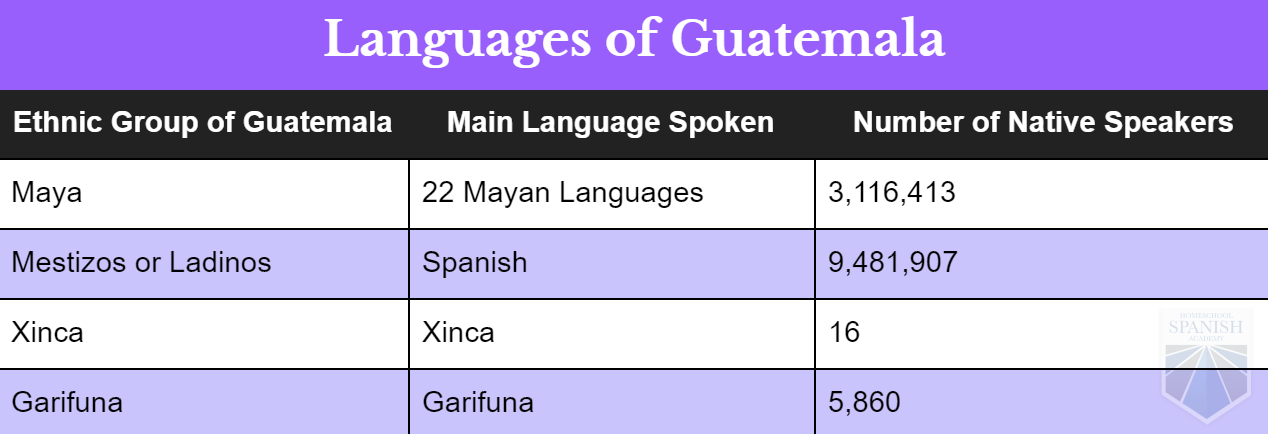
Learn more about Guatemala’s culture and ethnic groups here!
*Information on the number of native speakers from 2002 Census.
Spanish in the context of indigenous languages in Guatemala
Although Spanish is the “main” official language of Guatemala, a big percentage of the population does not speak Spanish! But how does this happen? The Spanish arrived in Guatemala almost 500 years ago in 1524 AD and as part of their colonization, they taught the indigenous people Spanish.
While 500 years may seem like enough time for everyone to learn Spanish, Guatemala is a country divided (and united!) by different cultures and landscapes. The various groups did not always accept a new language being imposed on them (who would?). Plus, the fact that some villages are so far removed from political, economic, or cultural centers allowed for many to just keep living their life without needing to learn a new language.
This is all now changing, but we’ll talk more about Spanish in Guatemala in another blog post! In the meantime, you can read a little something on Guatemalan history here.
Something to keep in mind: The Spanish of each Spanish-speaking country is greatly influenced by the languages the indigenous populations spoke or still speak! That’s the reason why there are sometimes big differences in the words the people of different Spanish-speaking countries use.
Y ahora, and now, exploremos the other languages of Guatemala!
Mayan languages
According to the 2002 census, 41% of the Guatemalan population identify themselves as indigenous (descendants of the Mayans). All these people speak various Mayan languages, and each one is a descendant of the language Protomaya, which came to life some 6,000 years ago! Yes, it’s been a long time! There are now 22 indigenous Mayan languages spoken in Guatemala, each spoken by a different cultural group! And yes, each one of them is a language of their own (not a *dialect!) with unique grammar, sounds, and vocabulary!
*dialect: “A particular form of a language which is peculiar to a specific region or social group.” Thanks, Oxford English Dictionary!
Let’s have a look at these 22 Mayan languages:
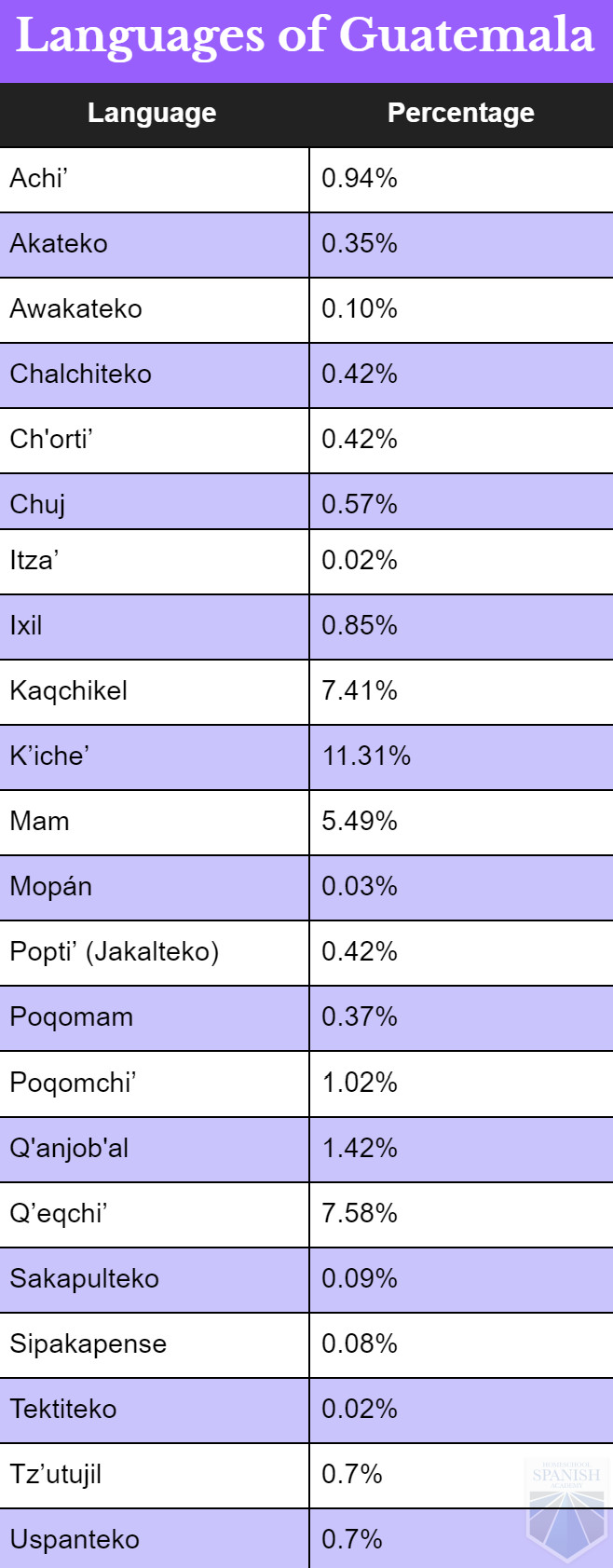
As you can see, only a very small percentage of the population speaks each of the Mayan languages! These numbers have greatly decreased in the last few years and are still rapidly declining due to multiple reasons. For one, technology is only available in certain languages. Similarly, most services and information are only accessible in Spanish. People are also moving to bigger cities for work or studies, and because of that many families consider it more important for their children to learn Spanish than an indigenous Mayan language. Parents and grandparents have struggled to live in a country where they cannot speak the official language, and they don’t want their children to have that same experience.
However, it’s important to mention that Guatemala’s government and different NGOs have started campaigns to promote Mayan language learning in schools and through any possible platform. The thing is, a language is not only a set of words we use to communicate with others. Languages carry the entire historical background of a whole culture! As such, it is important to value and cherish each Mayan language as much as we value and cherish all those beautiful colors we see when we visit a Guatemalan market!
Check out these quotes by Guatemalans to understand a little bit more about the importance of language as part of a culture: Discovering Treasures Through Spanish Quotes
Xinca
Xinca is a language that doesn’t belong to the same group as the other 22 indigenous Mayan languages. Its origin is unknown, but it used to be widely spoken throughout Guatemala, El Salvador, and Honduras. While some sources say the language is extinct, others say there are currently only about 100 people who speak this language.
Garifuna
Garifuna is the only language from the Arawakan language family spoken in Central America. All other languages from this language family that are not extinct, are spoken in Brazil, Peru, Colombia, Venezuela, Guyana, French Guiana, and Suriname. Up until 1797 when the Garifuna people were deported to Honduras, the language was only spoken in some Antillean Islands. Now, a total of about 200,000 people speak this language throughout Honduras, Guatemala, Belize, Nicaragua, and the US. If you’d like to learn more about the Garifuna culture, check out this documentary film in Garifuna language (and English): Garifuna in Peril.
Takeaway
Language is a huge part of culture! When you learn a language, you’re not only learning to say things with other words, but you’re venturing into a new world of ideas and customs. Continue learning more about Guatemalan culture and language by scheduling a FREE CLASS with us today!

Want to learn more about Latin American culture? Check out our latest posts!
- Are Bilingual Children More Likely to Experience a Speech or Language Delay?
- Top 10 Places to Visit in Guatemala City, Guatemala
- Learn About Hispanic History: Were Hispanics Slaves?
- Celebrating Culture and Joy: The Magic of Carnival in Spanish-Speaking Countries
- 15 Mouth-Watering National Dishes of Latin America
- Discovering The Mayan Languages
- The 10 Most Common Spanish Surnames in The U.S
- Everything About Mexican Christmas Traditions
- Making Chiles Rellenos - July 5, 2019
- Chanin - April 26, 2019

